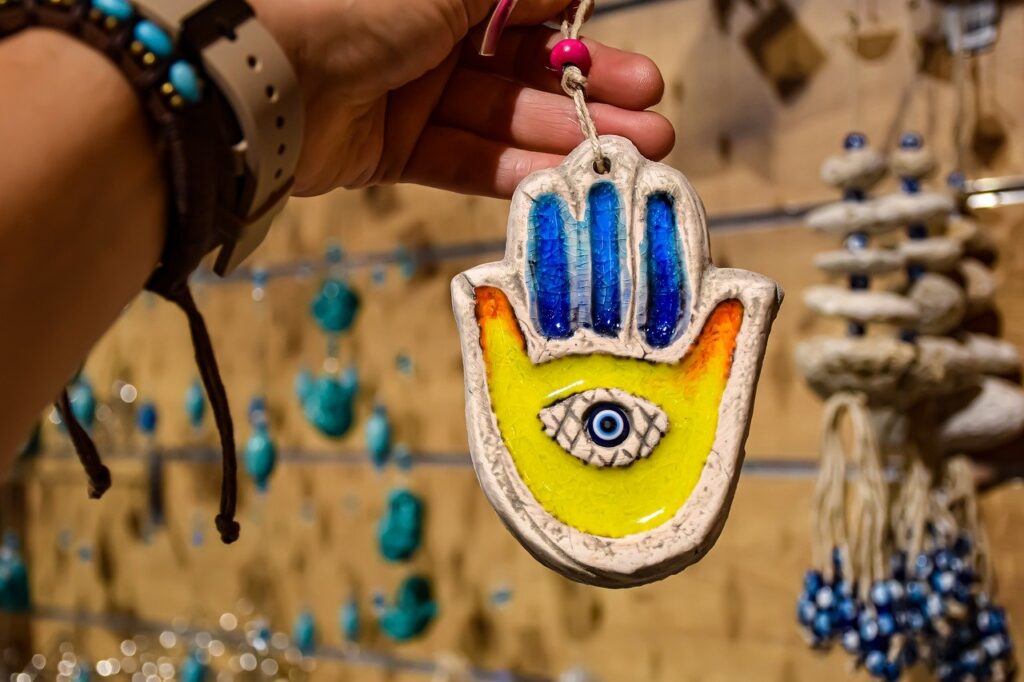Hamsa is a very popular and distinctive symbol that is used in various countries for more than a thousand years. It can be used as jewellery and art or showpieces. Hamsa has different meanings over cultures. Some people don’t believe in it and don’t consider it powerful. Are you a bit fascinated about the symbol? Let’s begin looking into some important aspects of the Hamsa symbol.

Meaning and History
Hamsa is a palm-shaped totem famous all over the Middle East and North Africa as a symbol of the Hand of God. It is typically used in ornaments and wall hangings. It is also called Hamsa Hand as it depicts an open right hand and endorsed as a sign of protection by the people who believe in it, throughout history.
The hamsa is believed commonly by some Muslims and Jews, as a protective sign against the evil eye. The symbol first came to light in the ancient Carthage which is now known as Tunisia, and Mesopotamia which is now known as Iraq. The Hamsa hand has its origin at least 1800 years ago, therefore, it is also known as one of the earliest historic symbols.
Symbolism
The Hamsa Hand (also called Khamsa), specifically the open right hand, is a symbol of protection. It is highly efficacious in diverging the evil eye and along with this, it also represents power, strength, and blessings.
The hamsa hand has a wide variety of names in different cultures that include Hamesh, Hamsa, Chamsa, and Khamsa. It also has its acclamations as the Hand of Fatima, Hand of Aaron, Hand of Miriam (Moses’s sister). Moreover, there are two major styles of Hamsa hand. The first style represents a shape like a regular hand, and the other style represents a hand with two symmetrical thumbs. The second style is the most renowned. The hamsa hand can be worn facing up or down, it brings luck, happiness, health, and good fortune to its owner.
Various Interpretations Across Different Cultures
The Hamsa hand has a wide variety of interpretations, among different cultures or languages. ‘Hamsa’ name is inspired by the five fingers on the hand.
In the Hebrew, the number five is called ‘hamesh’ The five books of the Torah are depicted by ‘Hamesh’. Interestingly, the fifth letter of the Hebrew alphabet is ‘Hey’ which is one of God’s holy names.
In Judaism culture, Hamsa hand is interpreted to be the Hand of Miriam and is symbolized as the five senses of its owner as an attempt to praise God.
It is called ‘Khamsah’ or ‘Khamesh’ which means five and also the five fingers of the hand in Arabic.
In Islamic culture, the hamsa related to the Five Pillars of Islam. Hamsa’ symbolizes the Hand of Fatima, who is the daughter of the Prophet Mohammed as per the Islamic culture.
Usage of Hamsa
The hamsa hand sometimes embraces an evil eye symbol, that style of Hamsa hand is believed to protect against the evil eye. People usually wear it as a pendant or neckpiece but is also used for house decorations, key chains, baby carriages, and other jewellery items or art pieces. People who have trust in the Supreme Power, wear this amulet regardless of what religion they follow or belong to.
Final words
Hence, Hamsa hand is a potent symbol that brings several good things towards a person who wears it. The Hamsa hand symbol helps you in the attainment of a greater state of responsiveness by rendering you a direct connection with the positive forces or vibes. It facilitates us in imbibing positive qualities and brings profound meaning and apprehensions. Other than its potent explications, it’s an adorable work of art too.
